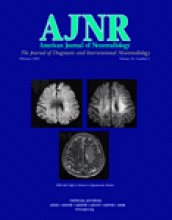Abstract
Summary: Solitary aneurysms of spinal arteries lacking associated vascular malformations are rare. We report three patients with spinal subarachnoid hemorrhage (SAH) due to rupture of such aneurysms, which regressed spontaneously, as confirmed on conventional angiography. One patient had spinal SAH with presumed spontaneous dissection of a segmental artery. In the other two, SAH resulted from ruptured fusiform aneurysms of the artery of Adamkiewicz immediately proximal to the anterior spinal artery. Solitary aneurysms of the spinal arteries appear to be etiopathologic entities completely different from intracranial aneurysms. Spontaneous occlusion seems to be common, justifying a wait-and-see strategy rather than urgent treatment.
- Copyright © American Society of Neuroradiology












